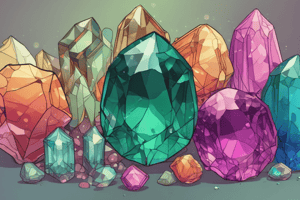Podcast
Questions and Answers
What is the common environment in which Tourmaline typically forms?
What is the common environment in which Tourmaline typically forms?
- Igneous and metamorphic rocks (correct)
- Limestone caves
- Volcanic ash deposits
- Sedimentary rock formations
Which variety of Tourmaline is most commonly associated with protection?
Which variety of Tourmaline is most commonly associated with protection?
- Pink Tourmaline
- Black Tourmaline (Schorl) (correct)
- Green Tourmaline
- Watermelon Tourmaline
Which of the following properties of Tourmaline makes it suitable for use in electronic equipment?
Which of the following properties of Tourmaline makes it suitable for use in electronic equipment?
- Piezoelectric properties (correct)
- High color saturation
- Low thermal conductivity
- Acid resistance
What is the Mohs hardness of Tourmaline, indicating its durability for everyday wear?
What is the Mohs hardness of Tourmaline, indicating its durability for everyday wear?
Which source is NOT one of the primary ones for sourcing Tourmaline?
Which source is NOT one of the primary ones for sourcing Tourmaline?
Flashcards
What is Tourmaline?
What is Tourmaline?
Boron silicate mineral known for a wide array of chemical compositions and colors.
Tourmaline Formation
Tourmaline Formation
Typically forms in igneous and metamorphic rocks like granite, pegmatite and schist.
Black Tourmaline (Schorl)
Black Tourmaline (Schorl)
Most common type of tourmaline known for its protective properties.
Piezoelectric Property
Piezoelectric Property
Signup and view all the flashcards
Tourmaline Care
Tourmaline Care
Signup and view all the flashcards
Study Notes
Overview
- Tourmaline is a boron silicate mineral complex with a wide variety of chemical compositions.
- It is widely known as a gemstone and is popular in jewelry.
Formation
- Typically forms in igneous and metamorphic rocks.
- Commonly found in granite, pegmatite, or schist environments.
Chemical Composition
- Composed of elements like aluminum, iron, magnesium, sodium, lithium, and boron.
- Notable for its wide range of colors due to different elemental inclusions.
Varieties
- Black Tourmaline (Schorl): Most common variety, often used as a protective stone.
- Pink Tourmaline: Often associated with love and emotional healing.
- Green Tourmaline (Verdelite): Valued for its vibrant color, linked to growth and renewal.
- Watermelon Tourmaline: A unique bi-color variety with pink and green sections.
Properties
- Known for its strong piezoelectric and pyroelectric properties.
- Mohs hardness of 7-7.5, making it suitable for everyday wear in jewelry.
- Often exhibits pleochroism, displaying different colors when viewed from different angles.
Uses
- Jewelry: Rings, necklaces, bracelets, and earrings due to its beauty and durability.
- Industrial: Used in electronic equipment due to piezoelectric properties.
- Healing: Believed to have metaphysical properties, promoting balance and purification.
Care
- Clean with mild soap and warm water.
- Avoid harsh chemicals and high heat to maintain durability.
Market
- Sourced primarily from Brazil, Madagascar, and the United States.
- Value determined by color, clarity, and size of the stone.
Fun Facts
- The name "tourmaline" comes from the Sinhalese word "turmali," meaning "mixed gems."
- Often used in Feng Shui and holistic practices for its energetic properties.
Tourmaline Overview
- Tourmaline is a mineral with a complex chemical composition containing boron silicate and various other elements like aluminum, iron, magnesium, sodium, lithium.
- It's noted for its diverse range of colors, which are attributed to the varying elemental inclusions in each variety.
Tourmaline Formation
- Typically forms in igneous and metamorphic rocks, specifically in granite, pegmatite, or schist environments.
Tourmaline Varieties
- Black Tourmaline (Schorl): Most common variety, often used for protection.
- Pink Tourmaline: Associated with love and emotional healing.
- Green Tourmaline (Verdelite): Vibrant green color, linked to growth and renewal.
- Watermelon Tourmaline: Unique bi-color variety, with pink and green sections.
Tourmaline Properties
- Known for its strong piezoelectric and pyroelectric properties.
- Exhibits a Mohs hardness of 7-7.5, making it durable for everyday wear in jewelry.
- Often displays pleochroism, showing different colors depending on the viewing angle.
Tourmaline Uses
- Jewelry: Used in rings, necklaces, bracelets, and earrings due to its beauty and durability.
- Industrial: Utilized in electronic equipment because of its piezoelectric properties.
- Healing: Believed to possess metaphysical properties, promoting balance and purification.
Tourmaline Care
- Clean with mild soap and warm water.
- Avoid harsh chemicals and high heat to preserve its durability.
Tourmaline Market
- Primarily sourced from Brazil, Madagascar, and the United States.
- The value of tourmaline is determined by its color, clarity, and size.
Tourmaline Fun Facts
- The name "tourmaline" originates from the Sinhalese word "turmali," meaning "mixed gems."
- It's often used in Feng Shui and holistic practices for its perceived energetic properties.
Studying That Suits You
Use AI to generate personalized quizzes and flashcards to suit your learning preferences.




